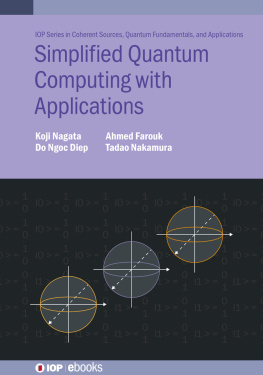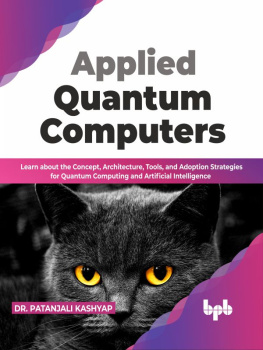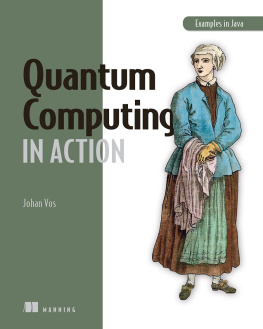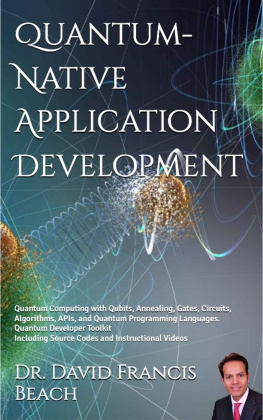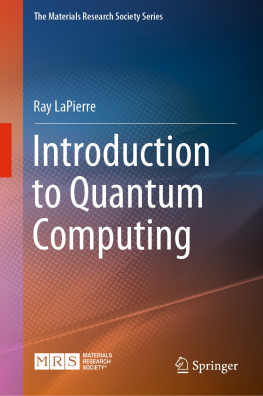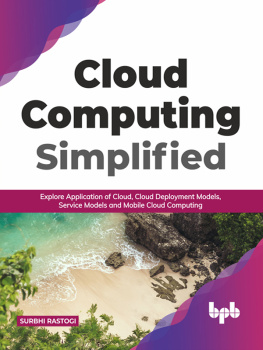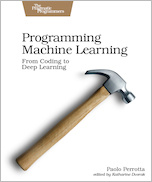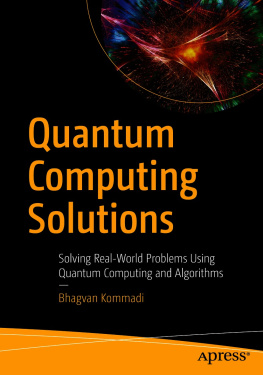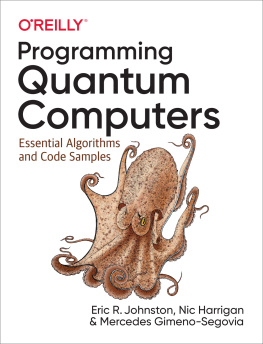Koji Nagata - Simplified Quantum Computing with Applications
Here you can read online Koji Nagata - Simplified Quantum Computing with Applications full text of the book (entire story) in english for free. Download pdf and epub, get meaning, cover and reviews about this ebook. year: 2022, publisher: IOP Publishing, genre: Romance novel. Description of the work, (preface) as well as reviews are available. Best literature library LitArk.com created for fans of good reading and offers a wide selection of genres:
Romance novel
Science fiction
Adventure
Detective
Science
History
Home and family
Prose
Art
Politics
Computer
Non-fiction
Religion
Business
Children
Humor
Choose a favorite category and find really read worthwhile books. Enjoy immersion in the world of imagination, feel the emotions of the characters or learn something new for yourself, make an fascinating discovery.
- Book:Simplified Quantum Computing with Applications
- Author:
- Publisher:IOP Publishing
- Genre:
- Year:2022
- Rating:5 / 5
- Favourites:Add to favourites
- Your mark:
- 100
- 1
- 2
- 3
- 4
- 5
Simplified Quantum Computing with Applications: summary, description and annotation
We offer to read an annotation, description, summary or preface (depends on what the author of the book "Simplified Quantum Computing with Applications" wrote himself). If you haven't found the necessary information about the book — write in the comments, we will try to find it.
Simplified Quantum Computing with Applications — read online for free the complete book (whole text) full work
Below is the text of the book, divided by pages. System saving the place of the last page read, allows you to conveniently read the book "Simplified Quantum Computing with Applications" online for free, without having to search again every time where you left off. Put a bookmark, and you can go to the page where you finished reading at any time.
Font size:
Interval:
Bookmark:

Simplified Quantum Computing with Applications
Koji Nagata
Department of Physics, Korea Advanced Institute of Science and Technology, Daejeon, Republic of Korea. E-mail: ko_mi_na@yahoo.co.jp
Do Ngoc Diep
TIMAS, Thang Long University, Nghiem Xuan Yem Road, Hoang Mai District, Hanoi, Vietnam
and
Institute of Mathematics, VAST, 18 Hoang Quoc Viet Road, Cau Giay District, Hanoi, Vietnam. E-mail: dndiep@math.ac.vn
Ahmed Farouk
Department of Computer Science, Faculty of Computers and Artificial Intelligence, South Valley University, Hurghada, Egypt. E-mail: ahmed.farouk@sci.svu.edu.eg
Tadao Nakamura
Department of Information and Computer Science, Keio University, 3-14-1 Hiyoshi, Kohoku-ku, Yokohama 223-8522, Japan. E-mail: nakamura@pipelining.jp
IOP Publishing, Bristol, UK
IOP Publishing Ltd 2022
All rights reserved. No part of this publication may be reproduced, stored in a retrieval system or transmitted in any form or by any means, electronic, mechanical, photocopying, recording or otherwise, without the prior permission of the publisher, or as expressly permitted by law or under terms agreed with the appropriate rights organization. Multiple copying is permitted in accordance with the terms of licences issued by the Copyright Licensing Agency, the Copyright Clearance Centre and other reproduction rights organizations.
Permission to make use of IOP Publishing content other than as set out above may be sought at .
Koji Nagata, Do Ngoc Diep, Ahmed Farouk and Tadao Nakamura have asserted their right to be identified as the authors of this work in accordance with sections 77 and 78 of the Copyright, Designs and Patents Act 1988.
ISBN 978-0-7503-3135-7 (ebook)
ISBN 978-0-7503-3133-3 (print)
ISBN 978-0-7503-3136-4 (myPrint)
ISBN 978-0-7503-3134-0 (mobi)
DOI 10.1088/978-0-7503-3135-7
DOI 10.1088/978-0-7503-4700-6
Version: 20220701
British Library Cataloguing-in-Publication Data: A catalogue record for this book is available from the British Library.
Published by IOP Publishing, wholly owned by The Institute of Physics, London
IOP Publishing, Temple Circus, Temple Way, Bristol, BS1 6HG, UK
US Office: IOP Publishing, Inc., 190 North Independence Mall West, Suite 601, Philadelphia, PA 19106, USA
IOP Series in Coherent Sources, Quantum Fundamentals, and Applications
About the Editor
F J Duarte is a laser physicist based in Western New York, USA. His career has expanded three continents while contributing in the academic, industrial and defense sectors. Duarte is editor/author of 15 laser optics books and sole author of three books: Tunable Laser Optics, Quantum Optics for Engineers, and Fundamentals of Quantum Entanglement. Duarte has made original contributions in the fields of coherent imaging, directed energy, high-power tunable lasers, laser metrology, liquid and solid-state organic gain media, narrow-linewidth tunable laser oscillators, organic semiconductor coherent emission, N-slit quantum interferometry, polarization rotation, quantum entanglement, and space-to-space secure interferometric communications. He is also the author of the generalized multiple-prism grating dispersion theory and pioneered the use of Diracs quantum notation in N-slit interferometry and classical optics. His contributions have found applications in numerous fields, including astronomical instrumentation, dispersive optics, femtosecond laser microscopy, geodesics, gravitational lensing, heat transfer, laser isotope separation, laser medicine, laser pulse compression, laser spectroscopy, mathematical transforms, nonlinear optics, polarization optics, and tunable diode laser design. Duarte was elected Fellow of the Australian Institute of Physics in 1987 and Fellow of the Optical Society of America in 1993. He has received various recognitions, including the Paul F Foreman Engineering Excellence Award and the David Richardson Medal from the Optical Society.
Coherent Sources, Quantum Fundamentals, and Applications
Since its discovery, the laser, has found innumerable applications from astronomy to zoology. Subsequently, we have also become familiar with additional sources of coherent radiation such as the free electron laser, optical parametric oscillators, and coherent interferometric emitters. The aim of this book Series in Coherent Sources, Quantum Fundamentals, and Applications is to explore and explain the physics and technology of widely applied sources of coherent radiation and to match them with utilitarian and cutting-edge scientific applications. Coherent sources of interest are those that offer advantages in particular emission characteristics areas such as broad tunability, high spectral coherence, high energy, or high power. An additional area of inclusion are those coherent sources capable of high performance in the miniaturized realm. Understanding of quantum fundamentals can lead to new and better coherent sources and unimagined scientific and technological applications. Application areas of interest include the industrial, commercial, and medical sectors. Also, particular attention is given to scientific applications with a bright future such as coherent spectroscopy, astronomy, biophotonics, space communications, space interferometry, quantum entanglement, and quantum interference.
Publishing benefits
Authors are encouraged to take advantage of the features made possible by electronic publication to enhance the reader experience through the use of colour, animation and video, and incorporating supplementary files in their work.
Do you have an idea of a book that youd like to explore?
For further information and details of submitting book proposals, see iopscience.org/books or contact Ashley Gasque at ashley.gasque@iop.org.
A full list of titles published in this series can be found here: https://iopscience.iop.org/bookListInfo/series-in-coherent-sources-and-applications.
Until recently quantum computing was not always confined to being very true itself in terms of the technology of quantum applied computers as quantum-gated computers. Of course, the other technological quantum-oriented annealing style computers have been productive and businesslike machines. However, very true quantum computers are not such annealers but quantum-gated computers in terms of the notion of computing.
This book focuses on the fundamental concepts of quantum-gated computing from the beginning: the Deutsch function evaluation algorithm, the DeutschJozsa algorithm, the Grovers search algorithm, the BernsteinVazirani algorithm for identifying linear functions, the Simon period finding algorithm, the Simon hidden subgroup algorithm and the Shor prime factoring algorithm. With computation in mind, this book takes a close look at the extraordinary connection between the Boolean algebra and quantum-gated computing as well as the new applications in a simplified manner. Our sincere objective is to build up quantum-gated computers operated by existing software/programs for electronic computers. Therefore, before doing this we study all the fundamental concepts on quantum-gated computers.
We would like to thank all our colleagues, especially Soliman Abdalla, Jaewook Ahn, Josep Batle, Mark Behzad Doost, Han Geurdes, Preston Guynn, Shahrokh Heidari, Wenliang Jin, Hamed Daei Kasmaei, Janusz Milek, Mosayeb Naseri, Santanu Kumar Patro, Germano Resconi, and Renata Wong for their valuable support at our original paper publication level. On the other hand, we cannot forget all the efforts of those who helped us in the preparation for publishing this book. In particular, Senior Commissioning Editor Ashley Gasque, Ebooks Editorial Assistants Claire Roy and Robert Trevelyan, and Accounts Payable Assistant Sam Needs deserve our sincere thanks for their complicated paperwork toward the great hard work in publishing the book.
Font size:
Interval:
Bookmark:
Similar books «Simplified Quantum Computing with Applications»
Look at similar books to Simplified Quantum Computing with Applications. We have selected literature similar in name and meaning in the hope of providing readers with more options to find new, interesting, not yet read works.
Discussion, reviews of the book Simplified Quantum Computing with Applications and just readers' own opinions. Leave your comments, write what you think about the work, its meaning or the main characters. Specify what exactly you liked and what you didn't like, and why you think so.

